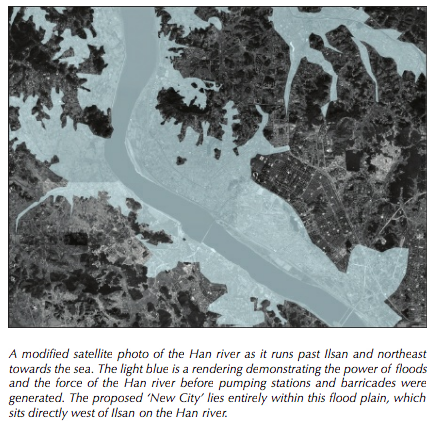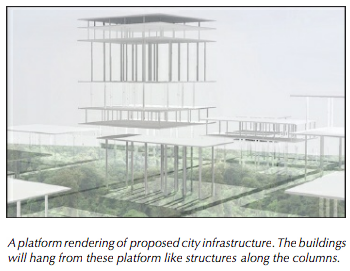Written by Evan Hall, Junior Researcher ’09-10
Architecture in Seoul has two dominant movements of urban development, the first one being the development of large scale planned architecture (such as new apartment towns) and the second being the vernacular. Vernacular is defined as “the language or dialect spoken by the ordinary people in a particular country or region.” When given in the context of urban architecture in Seoul, there are many examples of structures that have been built by ordinary people (ordinary people being Korean contractors and clients) that are intrinsically Korean in design and implementation. It is these Korean intrinsic principles of Korean vernacular architecture found all over Seoul in diverse forms that expresses the true essence of an architecture without formal planning, a sense of randomness and balance that is core to Korean cultural beliefs and design traditions.
The following is an outline of topics that strive towards the discovery and proliferation of a Korean urban vernacular.
—
Making Architecture
It is through the process of creation that ideas may be expressed physically. Urban architecture is a very sensitive form of expression. In other words, physically making structures in the city is vulnerable to many types of failures and tests. In order to make successful plans for architecture, the tectonics, typology and topology must be equally balanced and considered. When one of these three is under or over considered, the physical architecture is not fulfilling its duty, and can actually damage the city.
Erasing Architecture
Erasing architecture means removing certain qualities of planning in the process of constructing buildings and cities. The two dominant movements of architecture in Seoul can be put on a spectrum of erasing architecture. There are plans for urban architecture that take away a sense of well being and are disconnected from the city. These plans are erasing architecture in a way that is harmful for successful social integration. On the other hand, there are beneficial plans that allow freedoms and facilitate well being. It is important to acknowledge that these two functions are operating simultaneously within Seoul, and that the former is harmful to society where the latter is beneficial.
The New City Phenomenon
In Korea, new cities (신도시) are a common sight as Seoul slowly expands through the process of planned urban sprawl. This is when empty land, often agricultural, is purchased in large quantities and developed into a city of several hundred thousand people in a short time frame, often 10 years. These situations are an example of hyper development, which often lack true Korean culturally influenced design principles. Through a study of population fluctuations and population densities in five of the major new cities surrounding Seoul, the sheer intensity of this phenomenon is further understood. Here are a series of studies from the early 2000’s denoting population movements within Ilsan and Bundang.
Flooding
Seoul is in a constant state of submersion from the Han river. There are now more than fifty pumping stations throughout Seoul consistently pumping water out of the city and back into the river. These systems are highly stressed during the rainy seasons, and serves as the new age gates of Seoul, protecting it from natural disaster.
JDS — The Site of a New, ‘New City’
In the 8,000,000 square meters of agriculture north of Ilsan, there is a new city currently being planned. The site, now known simply JDS, is currently under controlled flooding to bring water to the rice paddies. Grids of 100 meters by several hundred meters make up an intricate network of irrigation. The plans currently being proposed by the construction companies for a new city call to completely erase this irrigation system, in a plan bearing a striking resemblance to those for Ilsan and Bundang. Mountains will be flattened and rivers will be filled. Although the plan has many supporters within the government, there have also been objections, and the design is being reconsidered. Even as construction is frozen, investors continue to purchase the land and the government continues to build new freeways based on the old plan.
This new land has a chance to become a Korean vernacular, a paradigm in Korean urban politics and city planning. The irrigation systems that were used to supply water to the rice fields can be adapted, not destroyed. The pumps that constantly carry water out of the JDS site can be utilized to produce a new standard for sustainability and social integration. It is possible to control the flooding of the Han on this site while building a new type of city, one which is flexible and diverse.
Planning without a Plan — Maximizing the Customization of the Physical
Planning a city is comparable to planning society itself. No one organization or institution is capable of this feat alone; therefore the plan must be flexible and changeable, natural, and must resemble an untamed garden. Although portions of the city are very controlled and planned, others are more free to change. These areas are the market streets, the hanok villages, and also the high density shopping districts. Within these vernacular conditions of urban Seoul, exceptions to the city plan are rampant. Those who are making, building, and customizing the city plan are the city’s gardeners. A flexible city plan allows these gardeners to express their place in society spatially. It is the goal of a city to promote an untamed garden of interaction, individual expression, and diversity.
Making a Flexible Korean City: Bohosu City (보호수도시)
City planning is contradictory: the more restrictions and rules that exist, the more difficult it is to compose an original condition. Many rules are so strong they will never adapt. Apartment complexes are a stringent example of such rules. Other plans, such as Seun Sang-ga (세운상가), were designed to be integrated into the city but failed. It is essential to find anomalies of vernacular Korean architecture and to promote their future proliferation. It is our duty as architects to understand the needs of the city while offering rules that promote individual control over one’s environment.
Bohosu City means nurse tree in Korean (or literally translates to “protected waters”). A nurse tree is a large, hardy tree that protects a slower-growing tree or plant. The idea for this city is that the initial infrastructure will offer a template for a new city to prosper, but will one day be completely erased by the people, the gardeners of the untamed city.
The models and drawings on this page comprise the beginnings of my thesis here in Korea. The project involves controlled flooding and a return to the natural state of the JDS site. The city infrastructure will be established above nature, with only columns and foundations penetrating the surface. Within this floating infrastructure, large companies and common individuals alike are able to purchase land and develop freely within the rules of the flexible plan.



